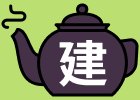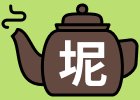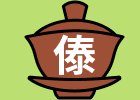Product detailed description
Overview
Premium sheng puer tea from Mengsong Tea Mountain (勐宋), which was pressed in the spring of 2024. The tea leaves come from mix of mature tea trees (qiaomu 桥木) and ancient tea trees (gushu 古树) and were processed by Shanshan's tea mentor, Liang. Liang belongs to the Han ethnic group (汉族), which produces premium and limited tea editions from new and ancient tea mountains.
This tea comes from the limited edition "Six New Tea Mountains" (xinliu dachashan 新六大茶山), comprising six tea cakes: Bulang (布朗), Bada (巴达), Nanqiao (南峤), Nannuo (南糯), Mengsong (勐宋) and Jingmai (景迈), which we now sell both individually or as a set. The tea is sold in the form of 100 g pressed cake (bingcha 饼茶), which is suitable for long-term storage.
Tea profile (akt. 20-11-2024)
- Aroma: Flower scent with mild honey tones
- Colour: The tea transitions from transparent yellow-white tones to darker golden shades
- Taste: Citrusy (lemon) and vegetable (olives and bear garlic) with tones of sweet honey and burned wood
For more information, follow our tea journal (coming soon). :-)
Additional parameters
| Category: | Teas |
|---|---|
| Distributor: | Liang |
| Packing: | 100 g |
| Tea mountain: | Mengsong 勐宋 |
| Year: | 2025-2019 |
| ? Producer / Výrobce: | FH-05, Liang, Han (汉族) |
| ? Origin / Původ: | Mengsong (勐宋) |
| ? Harvest / Sklizeň: | Q1/2024, 1600-2000 m.a.s.l. |
| ? Processing / Zpracování: | Hand-picked, factory tea |
| ? Quality / Kvalita: | Mixed (qiaomu 乔木, gushu 古树) |
| ? Type / Druh: | Shengcha (生茶), bingcha (饼茶) |
| ? Rating / Hodnocení: | Premium quality (4/5) |
| ? Best before / Minimální trvanlivost: | 4/2069 |
Recommended preparation
Step 0 (Weighting): Put the 4-6 g (amount for 2-3 tea lovers) or 7-8 g (amount for 4 and more tea lovers) into the prepared tea container. Normally, we use tea gaiwan or teapot between 140 ml to 200 ml. If you have a smaller tea container (140 ml or less) or bigger tea container (300 ml and more), we recommend adjusting the amount accordingly (i.e. 1 g: ± 25-50 ml).
Step 1 (Warming up): Pour the hot water 95-99˚C into the tea pottery, porcelain or glass without tea. After that, put the tea into the tea container and cover it with the upper lid of your container. The tea should stay in the tea container for about 20-40 seconds, which will help to develop the aroma.
Step 2 (Waking up): Pour the hot water 95-99˚C into the tea pottery, porcelain or glass with tea and leave it there for a few seconds (3-5 seconds). The first two infusions will help to flush out the dust and open the tea leaves, which will enrich the tea taste. These infusions are supposed to be poured out without drinking.
Step 3 (Infusions): Considering the higher quality of the tea (old tea trees or ancient tea trees), there is no need to make long infusions for several minutes. We recommend making the first 10-15 infusions (approximately 2-3 litres of water) within 5-6 seconds. After the 15th infusion, we recommend increasing the time between 5-10 seconds. If you decide to make longer infusions, the number of infusions, as well as intensity and taste profile, may significantly vary.
Note:
Follow a similar procedure for "one piece teas" such as tea tangarine (xiaoqingan 小青玵), tea bamboo (zhutongcha 竹筒茶), tea slice (xiaofangpian 小方片), tea ball (longzhu 龙珠), and other similar forms of pressed teas.
For red tea (云南晒红), we recommend a temperature between 90-95˚C.
During the summer months, tea can also be prepared in a cold form by leaving it soaked in the refrigerator overnight instead of pouring hot water over it. This preparation method is best suited for white (yunnan baicha 云南白茶) and red teas (云南晒红). The amount of tea for this type of preparation is directly proportional to the amount of water and the desired concentration of flavor. The disadvantage of this preparation method is that after long soaking, it will no longer be possible to create additional infusions.
Our tea preparation comes from Xishuangbanna tea culture, which brings the best experience from our teas. Feel free to experiment with tea dosages, temperatures and timing for steeping your tea according to your personal preference.
We wish you a good luck with your tea journey ~
Recommended conditions:
For the best storage conditions, keep your tea at room temperature (18-25˚C) in dry (50-60% wetness), dark and non-aromatic environment. Tea can be stored in glass, pottery or in zip-lock bags to avoid oxidation. Try to avoid storing the tea in the kitchen and other places with high humidity and aromas. We also recommend separating your teas according to your type (sheng + bai // hong + shu) at your storage place.
Most of our teas are intended for long-term storage, which will enhance their taste over time, similar to wine. For further information about long-term storage, please consult our tea master, Shanshan Lin, about the conditions and methods.
Note:
In the case of tea buds (yabao 芽苞) and red teas (yunnan shaihong 云南晒红), we recommend consuming the tea within 5 years of production. This is the best before date information, so you can still consume your tea even after this period.
For more information on long-term storage, please consult with our tea master, Shanshan Lin.
Water quality:
For the best-tasting experience, use the soft water. In fact, about 40% of your taste experience is influenced by water. The most vulnerable teas to water quality are shengcha (生茶) and Yunnan baicha (白茶), which have more complex taste and softer taste layers. If you use bottled water (e.g. Rajec, Nartes, Evian...), filtered water (e.g. Brita, Amway...) or water well water, the taste, aroma and colour may significantly vary. In case you use tap water, make sure the water pipes are in good condition (notably rust) and have a reliable water source (i.e., water source, chlorine, etc.).
Note:
The tea taste may vary significantly according to heating tools (electric kettle vs. cast iron, tin, enamel, or other types of vessels on open fire), types of teaware (porcelain and glass vs. unglazed tea pottery), the method of pouring, and the amount of water. Therefore, don't hesitate to experiment with different tea dosages, temperatures, and steeping times that better match your personal preferences.
We wish you good luck on your tea journey ~
Dosage:
If you are experimenting with the amount of tea and duration of infusions, keep in mind that our teas have strong vitality and can be prepared multiple times (10 or more infusions) so they may last the whole day for you.
Considering the higher quality of our teas, you do not need to sink the tea for minutes or artificially add more tea (over 8 g) in your teaware since you can prepare rich infusions with long-aftertaste.
Note:
Generally, we use tea gaiwan or teapot between 140 ml to 200 ml. If you have a smaller tea container (140 ml or less) or bigger tea container (300 ml and more), we recommend adjusting the amount accordingly (1 g: ± 25-50 ml).
Consumption:
The tea can be consumed within 24 hours from the first infusion. If you are unable to finish your tea within one day, you can also use it the next day.
For this purpose, make a short inter-infusion (5-10 seconds, depending on the number of used infusions) and pour it out in order to avoid the bacteria.
For further information, please, consult the tea preparation with the tea master, Shanshan Lin.

























